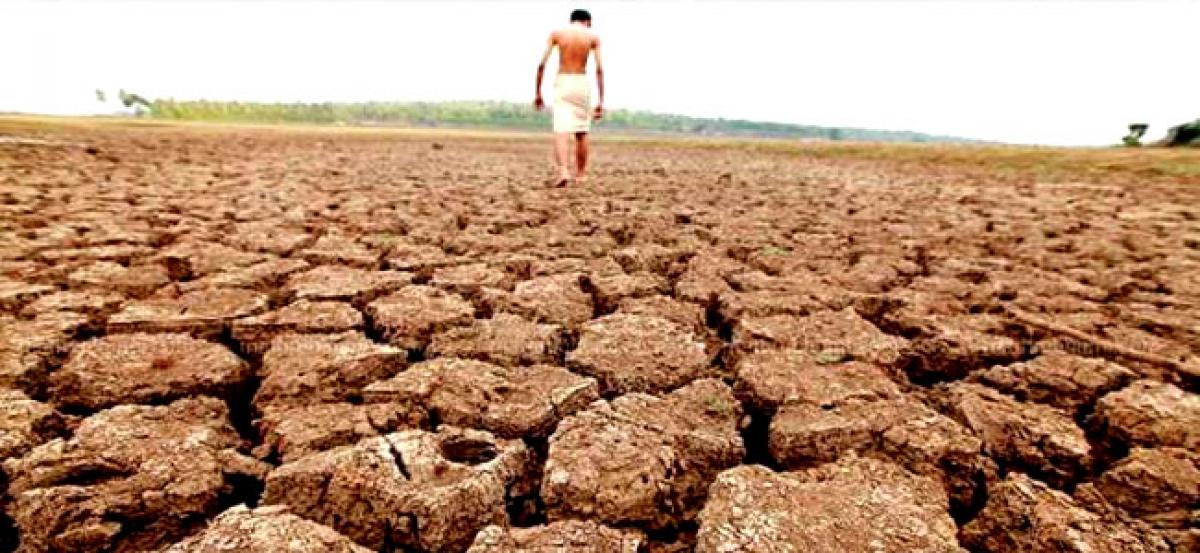Live
- Vizag mafia rules sand ramps in Srikakulam district
- Unselfishness is a Lie
- ICTPL welcomes maiden vessel MV KSL Fuyang
- BJP leaders mock Rahul's speech
- Analysing Happiness
- Two-day ToT organised for trainers
- Savarkar preferred Manusmriti to Constitution: Rahul
- Daily Horoscope for 15 December 2024: Embrace Today’s Insights of Your Zodiac Sign and Unlock Your Potential.
- Beyond The Flames
- CM warns officials of stringent action
Just In

There are many places in the district that are quite suitable to match the TS Eliot’s poem ‘Waste Land’ where people can sing only ‘drip drop drip drop drop drop drop, but there is no water’.
Nellore: There are many places in the district that are quite suitable to match the TS Eliot’s poem ‘Waste Land’ where people can sing only ‘drip drop drip drop drop drop drop, but there is no water’.
Actually, the district recorded excess rainfall in 20 mandals, normal in 16 mandals out of 46 mandals in the district, but still groundwater is at a depth of more than 30 metres in some places in rural areas and in majority of mandals witness above 15 metres of depth.
The maximum temperature in the district is 36-46 C deg during summer and the minimum temperature record during winter is 23-25 C deg. The rainfall ranges between 700 and 1000 mm through South West and North-East Monsoons. District gets majority rainfall only during North East monsoon and still this time district had witnessed sporadic rains in many parts due to active monsoon.
Majority mandals located on the west and north-west parts of the district have been witnessing low rainfall activity and significantly reduced groundwater levels. Amongst them Udayagiri, Duttaluru, Varikuntapadu and Marripadu come on top of the list where such complex climatic conditions prevail.
According to latest weather data; Varikuntapadu, Kondapuram, Jaladanki, Kavali, Bogole, Kaligiri, Vinjamuru, Udayagiri, Atmakur, AS Pet, Dagadarthi, Vidavaluru, Kodavaluru, Nellore, Kovur, Indukurpeta, TP Gudur, Venkatachalam, Manubolu, and Chillakur received excess rainfall during the current monsoon season that started from June till mid-September.
Against 83.40 mm of normal rainfall from June, the district recorded 92.30 mm with around 10.7 pc excess rainfall. On an average, water table in the district even during July has been 10.6 metres. Coastal mandal Vakadu also recorded 19.2 metres of depth on July 9. 16 mandals also received normal rainfall and only 10 mandals are having deficient situation during the one-month span since the monsoon had started.
“The state government has to consider special packages or improving water resources in the parched upland areas. Otherwise, local people would have to migrate to other parts for livelihood. It has been happening every year but this time the situation is slightly hopeful with intermittent drizzles,” said N Prasad, a social activist from Jadadevi in Varikuntapadu mandal.
Nellore: There are many places in the district that are quite suitable to match the TS Eliot’s poem ‘Waste Land’ where people can sing only ‘drip drop drip drop drop drop drop, but there is no water’.
Actually, the district recorded excess rainfall in 20 mandals, normal in 16 mandals out of 46 mandals in the district, but still groundwater is at a depth of more than 30 metres in some places in rural areas and in majority of mandals witness above 15 metres of depth.
The maximum temperature in the district is 36-46 C deg during summer and the minimum temperature record during winter is 23-25 C deg. The rainfall ranges between 700 and 1000 mm through South West and North-East Monsoons. District gets majority rainfall only during North East monsoon and still this time district had witnessed sporadic rains in many parts due to active monsoon.
Majority mandals located on the west and north-west parts of the district have been witnessing low rainfall activity and significantly reduced groundwater levels. Amongst them Udayagiri, Duttaluru, Varikuntapadu and Marripadu come on top of the list where such complex climatic conditions prevail.
According to latest weather data; Varikuntapadu, Kondapuram, Jaladanki, Kavali, Bogole, Kaligiri, Vinjamuru, Udayagiri, Atmakur, AS Pet, Dagadarthi, Vidavaluru, Kodavaluru, Nellore, Kovur, Indukurpeta, TP Gudur, Venkatachalam, Manubolu, and Chillakur received excess rainfall during the current monsoon season that started from June till mid-September.
Against 83.40 mm of normal rainfall from June, the district recorded 92.30 mm with around 10.7 pc excess rainfall. On an average, water table in the district even during July has been 10.6 metres. Coastal mandal Vakadu also recorded 19.2 metres of depth on July 9. 16 mandals also received normal rainfall and only 10 mandals are having deficient situation during the one-month span since the monsoon had started.
“The state government has to consider special packages or improving water resources in the parched upland areas. Otherwise, local people would have to migrate to other parts for livelihood. It has been happening every year but this time the situation is slightly hopeful with intermittent drizzles,” said N Prasad, a social activist from Jadadevi in Varikuntapadu mandal.
By P V Prasad

© 2024 Hyderabad Media House Limited/The Hans India. All rights reserved. Powered by hocalwire.com







